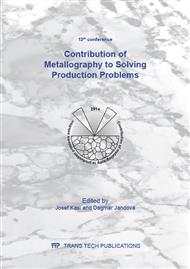p.79
p.85
p.95
p.102
p.108
p.115
p.121
p.131
p.141
Utilization of Light Microscopy for the Evaluation of Fracture Toughness of Cemented Carbides
Abstract:
Cemented carbides belong among materials with high hardness and wear resistance even at temperatures around 700 °C. These properties are due to carbide composite structure which is formed mainly of tungsten carbide (WC) in combination with a metal matrix (usually cobalt). A synergistic effect that has a positive impact on the final properties is obtained by the combination of hard carbides and a soft matrix. The high hardness of the cemented carbides is associated with a decrease in fracture toughness which in the case of cutting tools is an important property. It is therefore necessary to measure the value of fracture toughness and thus monitor the state of the material. In practice, the fracture toughness of cemented carbides is usually tested by indentation methods of metallographic samples. Therefore, this work focuses on the comparison and optimization of computational models for determining fracture toughness using indentation methods. Eight types of cemented carbides used for the manufacture of cutting tools were tested. Fracture toughness of selected cemented carbides was measured after heat loading.
Info:
Periodical:
Pages:
108-114
Citation:
Online since:
May 2015
Authors:
Keywords:
Price:
Сopyright:
© 2015 Trans Tech Publications Ltd. All Rights Reserved
Share:
Citation:


